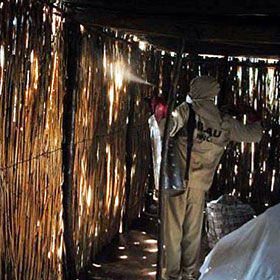Use of the ESPT in Mozambique
Two programmatic questions drove the ESPT pilot in Mozambique: 1) can IRS be effective in currently untargeted areas in southern Mozambique?; and 2) are the IRS insecticide formulations used by the NMCP effective over the whole transmission season? Guided by the ESPT and MEI technical assistance, the NMCP and partners selected appropriate indicators and sampling methods based on these questions, and pilot sites were chosen based on NMCP priorities. Training and ongoing mentorship was provided by the MEI’s local partner, the Manhiça Health Research Centre.

Primary data generated for question 1 included the resting and biting behaviors among primary and secondary vectors. This evidence demonstrated areas where IRS should be effective and other areas where, given exophagic and exophilic behaviors, IRS may not have an impact. For question 2, results demonstrated delayed mortality of vectors to insecticide-treated walls for six months, indicating that the IRS campaign needs to start later to ensure coverage for the peak transmission season for maximum impact.
ESPT-generated data resulted in selection of new areas targeted for IRS as part of the program expansion in the Mozambique-South Africa-Eswatini border region and added evidence to an IRS site-selection process that was previously based on non-scientific metrics (e.g., whether selected areas had historically received IRS). The ESPT also enabled the NMCP and partners to prioritize entomological indicators as well as highlighted information gaps for the NMCP to address.